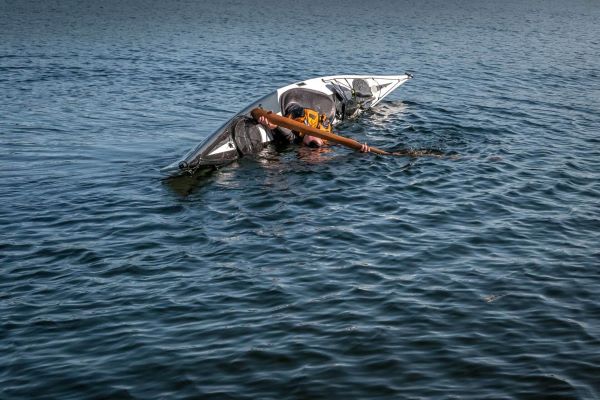Whitewater kayaking can be a thrilling and dangerous sport if not done properly. One of the most important skills you need to know in order to stay safe while whitewater kayaking is how to execute a whitewater kayak roll. There are several types of kayak rolls-the C to C roll, the sweep (screw) roll, the reverse screw roll, and the hand roll. In this article, you will learn how to execute the C to C roll and the sweep (or screw) roll so that you can stay safe while enjoying this exciting sport!
Prerequisite for a Whitewater Kayak Roll
Before you learn how to execute a roll, it is important that you have the following in your arsenal:
- A paddle, a fitting kayak, a helmet, a life jacket (PFD), and some swimming skills!
- The basic concepts of whitewater kayaking.
- Proper paddling technique
- The wet exit technique
- The balance brace
- Draw stroke technique
- Sweep stroke technique
- You need to be mentally prepared for the challenge and risk involved in executing a roll, as it can be a difficult maneuver to master initially.
With these prerequisite skills and mindset, you will be well on your way to learning how to execute a whitewater kayak roll!
What is a kayak roll and why do you need to know how to execute it
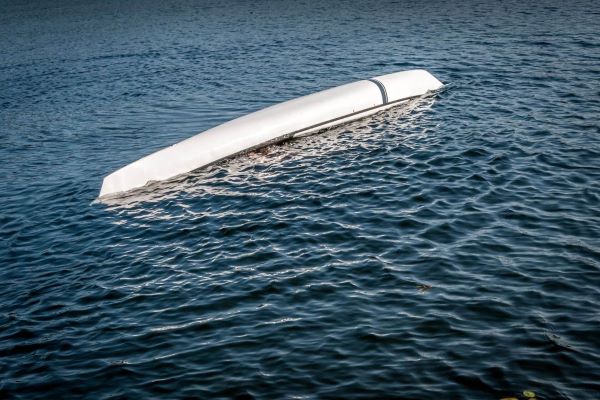
A kayak roll is a maneuver that helps you get back up on top of your kayak if you happen to capsize while whitewater kayaking.
Executing a kayak roll is an important safety skill to know if you want to participate in whitewater kayaking. It can be a difficult maneuver to master initially, but with practice, it can become second nature. The main purpose of a kayak roll is to help you get back on top of your kayak if you happen to capsize while whitewater kayaking. If you are unable to execute a kayak roll, there is a higher risk of being injured or even losing your life. That is why it is essential that you learn how to do it properly before heading out on the river.
The different types of kayak rolls
There are several different types of kayak rolls you can learn, depending on the type of whitewater kayaking you want to do.
C to C roll, sweep (screw) roll, reverse screw roll and hand roll are just some of the many kayak rolls that exist.
if you are doing straightforward river runs, sweep (or screw) roll or reverse screw roll is generally sufficient. However, if you are paddling in more difficult whitewater conditions, such as in a waterfall or over steep rapids, you may need to learn more advanced rolls like the C to C roll.
To start learning how to execute these rolls, it is best to get some basic instruction from an experienced kayaker or whitewater kayaking instructor. With practice and patience, you will soon be executing a roll like a pro!
Steps on how to execute a whitewater kayak roll
1. Set up phase: The C to C roll and the sweep (screw) roll
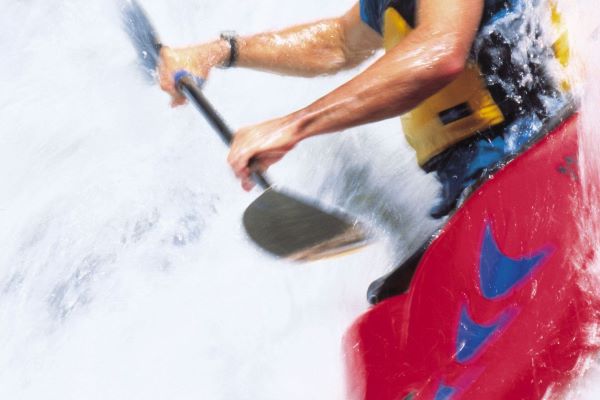
After your kayak capsizes, you move to the setup phase, also known as the home position. However, for practice purposes, you can assume the setup position before you flip yourself upside down.
If you intentionally flip yourself over for practice purposes, you may start with the set up phase while you are upright in the boat, placing the paddle parallel to the side of your kayak you want to execute the roll. The paddle blade should be facing upward while you are still upright.
However, in a real situation, you may not have time to position your paddle parallel to your boat as capsizing can happen very fast. What you should remember is that you should allow a free fall and let the capsize happen.
If your find yourself already underwater, to execute the setup position for a whitewater kayak roll, you need to bring your paddle alongside (parallel) your kayak. In this scenario, your paddle blade will be facing downward.
If performing the C to C roll, the most important part of this phase is to tuck your body as far as you can towards the surface of the water on the side of your kayak where you have aligned your paddle. This will make your hip snap (as explained below) for C to C roll more effective in bringing you back up.
Another important tip to note for your setup position is that your control (or dominant) hand should be holding the front part of the paddle.
So, if you are right-handed, this becomes your control hand. Likewise, if you are left-handed, this becomes your control hand. This means that if you are right-handed, you should set up your roll on the right side of your kayak. And if you are left-handed, your setup should be on the right side.
2. The catch phase
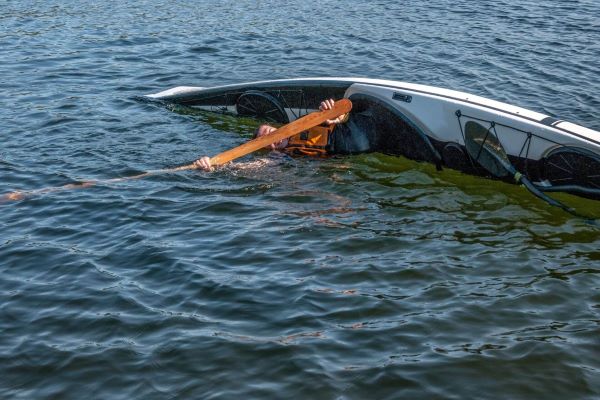
The catch phase is when you use your paddle as a leverage to provide support for the hip snap.
It is important to note that there is some variation in the technique between the C to C roll and the sweep (screw) stroke.
Catch phase for C to C roll
Orient the paddle from the home position so it is perpendicular (at 90 degrees) to the cockpit (the first C) – the face of your paddle blade in water should be facing downwards when you are underwater.
If you are properly set up from the home position, your blade will automatically be facing download when you are underwater. This can give you some leverage as you pull down (SLIGHTLY) with your control hand just before you perform your hip snap (second C). Timing is EVERYTHING here.
Your forearm of the other hand (your top hand) holding the paddle should be over your capsized kayak and will act as a pivot.
Catch phase for the sweep (or screw) roll
The catch phase for the sweep (or screw) roll is slightly different from that of the C to C roll. Once you are underwater, you should start to sweep your blade in a wide arc as you push down SLIGHTLY on your control hand (the hand that’s further away from your body on the side you want to perform your roll on).
Make sure you DO NOT apply a lot of downward pressure as you pull down while sweeping your blade backward.
To successfully execute the sweep roll catch phase, you want to make sure that you use a climbing angle as you sweep your paddle blade – the leading edge of your blade should be an open angle – as you would do in a sculling draw stroke but this time you are underwater. A climbing angle allows your leading edge angle to be open so that it is higher than your trailing edge. This way, your paddle will climb to the surface of the water as you sweep your paddle blade.
Note that you will not need much climbing angle as you will not need to apply a lot of downward pressure on your paddle. Also, you want your forearm to be as close to your body. This is different from reaching your other hand over your kayak as a pivot if you were to execute the catch phase for the C to C roll.
Remember your torso rotation while you sweep your paddle blade in the water. The best way to do this is to keep your eyes on your active blade (the blade in your control hand) as you drive your paddle in a sweeping motion.
3. The hip snap phase
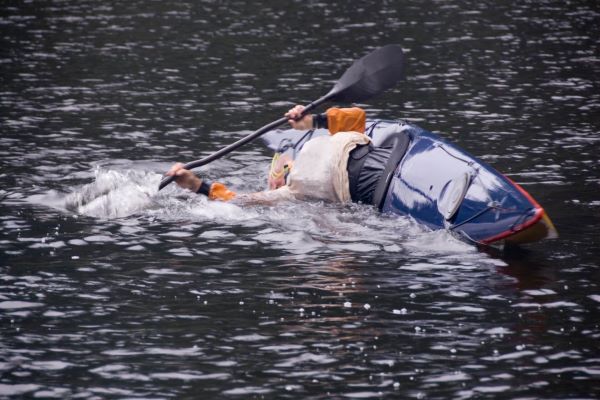
This is the most important part of the roll. It is what gets you back up. So you’ll need to practice to get a hang of this.
Whether you are executing the C to C roll or the sweep roll, your hip snap should take place after you get your paddle perpendicular to your kayak. When your paddle is at 90 degrees (or perpendicular) to your kayak, you get the maximum leverage as you apply the slight downward pressure immediately before executing the hip snap.
When executing the hip snap, there are some golden rules to note.
- You want your head and body stationery as you snap your hip as fast as you can. If you try to use your arms or body as the main force to go right back up, then you are likely not going to be successful.
- Getting your paddle perpendicular to your kayak at the time of the hip snap provides the maximum leverage you will need to successfully nail a hip snap.
- Snap the kayak upright with your hip movement as fast as you can.
With a successful hip snap, you can feel your kayak getting back upright, and then you are all EASILY set for a recovery position
4. Recovery Phase
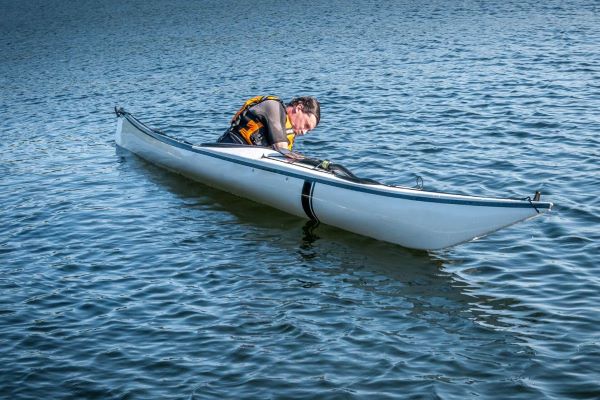
The recovery phase is how your body moves to the final position (upright) on top of your kayak after you perform the hip snap.
You simply swing your body upright with a slight bend backward. Some people prefer to bend forward.
The most important thing is to ensure that your head is the LAST part of your body you bring to the upright position. This is helpful to lower the center of gravity as you swing to the upright position. If you don’t bring your head up last, you are likely going to lift your top leg up (your top leg is supposed to push down with your hip snap). This will likely cause your kayak to capsize back in the water.
The importance of practicing your kayak rolls
No matter how confident you are in your kayaking skills, it is always important to practice your rolls. This is the only way to make sure that you’ll be able to execute them successfully when you’re in a real-life situation.
It’s also important to note that different kayaks may require different techniques to execute a roll. So it’s crucial that you practice with the type of kayak that you are using.
The best way to practice your kayak rolls is in a swimming pool. This will allow you to get more comfortable with the motion and ensure that you won’t have any trouble with the hip snap when you’re in deep water.
7 Tips on how to improve your kayak roll technique
Here are some tips to help you improve your kayak roll technique:
- Practice in a swimming pool. This will help you get more comfortable with the motion and ensure that you won’t have any trouble with the hip snap when you’re in deep water.
- Practice on the water using a rock or another person’s kayak as leverage.
- Make sure that your head is the last part of your body you bring to the upright position. This will lower the center of gravity as you swing to the upright position.
- Bend backward when recovering to the upright position. This will give you more stability as you come back up.
- Focus on keeping your body as still and balanced as possible throughout the hip snap, using major movements of the hip to snap the boat back up, while your top leg pushes down to support your hip snap.
- Take time to practice several different rolls until you find one that works well for you and feels comfortable in different water conditions.
- Consider taking a kayaking or other outdoor skills course to learn more advanced techniques and tips from experts in the field.
Final thoughts
Whether you are a beginner kayaker or an experienced paddler, it is always important to practice your rolls regularly. This will not only help you become more skilled and confident, but it can also help you stay safe out on the water in a variety of different situations. And with the right tips and techniques, there are many ways to improve your kayak roll and become a more skilled and confident paddler. So be sure to take the time to practice regularly, seek out expert guidance when needed, and keep pushing yourself to reach your full potential as a kayaker!
Leave a comment below and let us know what you think about improving your kayak roll technique, or share any tips or tricks that have helped you get better at this important skill. Whether you are a beginner or an experienced paddler, we would love to hear from you!
